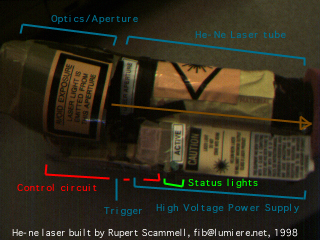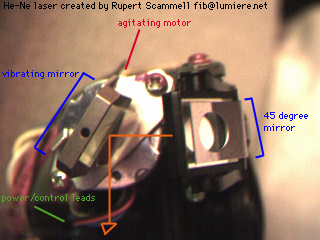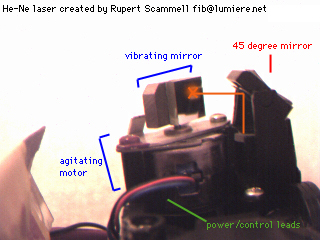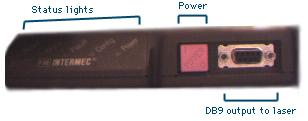
main page
(page note: I'm aware this page is huge. I'm going to thumbnail link the
images on it as soon as I can.)
Note: The laser has undergone extensive functional modifications since
this page was first written. A status update can be found here
I love to tinker with just about anything I can get my hands on. One of the coolest
things I've created in a while is a Helium Neon laser pointer, which I built from a
scrapped UPC barcode scanner (It was an Intermec 9510 if you're curious).
Here's what it looks like:

The laser is a Class IIa, and has a maximum output power of 1 milliwatt. It has several
interesting features, which are remnants of its old life as a barcode scanner. Within
the optics is a vibrating mirror, that creates a line of variable width when operational,
and simply acts as a 45 degree angle mirror and creates a point when deactivated.
The line width is controlled by a potentiometer located under the high voltage power supply.
Not shown in the picture are two IR sensors, mounted directly in front of and under the power
supply, which were used to relay data back to the base station. The laser is fairly small,
and measures approximately 7.5" (16.5cm) from behind the optics to the front of the IR
sensors. It's a little under 2.5" wide, and weighs less than a pound.
The laser is powered via a DB9 connector, which is attached to a base station that contains
dual RS-232 outputs, and a small onboard computer. I haven't tried to power the laser via
a standard PC serial port yet, however I believe that it probably uses a standard serial
connection.
Here's another photo of the laser, this time with the service cover removed from the
aperture:

As in the other image, the orange line indicates the path of the laser. The motor on the
mirror has an interesting quirk, in that every time the laser is activated, regardless of
whether the motor has been set to vibrate or not, the motor will recalibrate the mirror.
Here's a front view of the laser, again with the service cover removed from the optics:

The orange dot on the mirror is present because the terminating point of the ray would be
on your eyeball at this angle. The power and control leads are connected to one of two
circuit boards. The first is mounted behind the HV power supply, and the second is directly
underneath the He-Ne tube.
Here's a front view of the base that the laser is attached to:

As you can see, fairly straightforward. There are two DB25 ports at the back, and a power
connector. One DB25 is marked auxilliary, and the other modem. There's also an RJ11 port
built into the side.
If you're still interested, here's a photo of the underside of the power supply, showing
input pinout to the power base, and associated voltages. Here you go:

The power supply is fairly large and bulky, measuring
6.0" (15cm) long, 3.0" (8cm) wide, and 2.5" (7cm) high. It weighs in at about 2-3 pounds.
Another neat project, that I've only just started working on, is the design and implementation
of an online telemetry system for the UCR Visual Cognition and Performance Lab's coffeepot.
Unlike the vast majority of web coffeepots, which only show a visual of the coffeepot, this
system will be more akin to the wired soda machines located at CMU and MIT, that provide data on
usage, availability, etc. In exchange for providing hot, caffeinated beverages, I'm hoping
they'll give me a net connection and subnet for it. I'm shooting for coffeepot.ucr.edu.
Go here for updates on the status of the
online coffeepot.
Here are some technical specifications for the project:
Analog/Digital Interface: Probably a "CerealBox" 8 channel A/D D/A converter, with channel
layout as follows:
Channel 0 (A/D): Coffee temperature
Channel 1 (A/D): Carafe level
Channel 2 (A/D): Machine status (on, off, brewing)
Channel 3 (A/D): Time since last cup poured
Channel 4 (D/A): Mode control (set brew time, perform other functions)
Channels 5-8: Spare/future use.
Coffeepot: Proctor-Silex
"Morning Maker" 12 cup coffeemaker.
Computer: The 486 sitting in the corner of the lab should work well, when I get around
to putting it back together, and finding an ether card for it. It's an old Dell server,
and has a 1 gig drive, with about 64mb of memory. The CerealBox will just be hooked to
a standard RS-232 serial port.
When I finally get it all put together, I'll put up pictures here, and include a link to
the website.
fib@lumiere.net
5.13.1999
about me | projects
|
music | trashing
| "art" | links | contact | work | ideas |
code | changes





